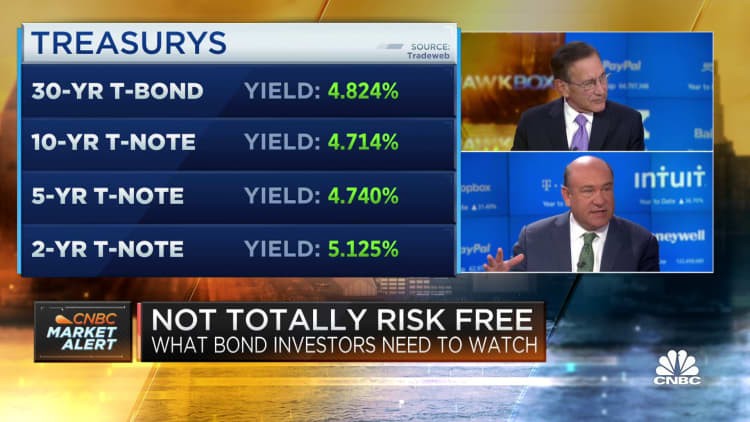Fixed income securities are back in the spotlight. How Investors Can Benefit

Peshkova | Istock | Getty Images
Fixed income investing is entering an exciting new era and investors should take note. Decades of low interest rates, driven by global central banks, have prevented the bond market from generating attractive and reliable returns.
But in recent quarters, we have seen interest rates rise dramatically, a development that investors should not fear but rather embrace. Bonds are now all the rage in investment circles, and while they’re not as trendy as Taylor Swift, their popularity has certainly increased in recent months along with interest rates.
Interest rates have increased significantly since the start of 2022. As an example, the yield to maturity of the benchmark index US Treasury at 10 years is now close to 5%, up more than 3.30%.
The yield on 10-year bonds and other Treasury bills is now the highest since the start of the Great Financial Crisis in 2007. In addition to the rise in nominal interest rates, we have also seen a similar rise in bond yields. real interest (rates adjusted for inflation).
Using market-derived forward-looking inflation expectations to adjust nominal yields, the current real yield on the 10-year Treasury is approaching 2.5%, a level that should excite bond investors.
To be sure, the journey to higher yields has been painful for bond investors. In 2022, the total return of the Bloomberg Aggregate Bond Index, a broad universe of U.S. taxable bonds, returned -13.01% (according to Bloomberg as of December 31, 2022), the worst calendar year performance for this index since its creation in 1976.
Other sectors of the bond market have experienced similar difficulties, but with pain comes gains. Higher rates now can provide a higher total return and greater stability of returns in the future.
When calculating fixed income yields for most bonds, there are two components: price yield and income yield.
At the start of 2022, little income was being generated by high-quality bonds. The negative total returns for the year were driven by large price declines accompanied by a small positive revenue contribution.
As an example, the Bloomberg Aggregate Bond Index had a price return of -15.3% and an income return of +2.3%. However, the actuarial yield of the Bloomberg Aggregate Index is now 5.64% (according to Bloomberg as of October 17, 2023), more than 3.5% higher than at the start of 2022.
As a result, we would expect a much larger positive contribution from income to future returns and a less negative contribution from price returns.
How can an investor benefit from a higher yield environment?
We suggest investors re-evaluate their current bond allocation and slightly increase their exposure in a manner consistent with their current portfolio position, investment objectives and risk tolerance.
While we don’t expect rates to move in the near term, we believe we are entering more of a range-bound yield market for longer-dated bonds. This is consistent with our expectations for no additional rate hikes from the Federal Reserve this cycle and a continued decline in inflation in the near term.
To effectively capture higher yields, we advise a modest increase in longer maturity bonds as well as an allocation to shorter maturity bonds in a dumbbell approach, while avoiding intermediate maturities where possible.
Given the inverted shape of the yield curve, a dumbbell approach can help maximize overall portfolio returns and provide additional yield if long-term rates decline.
For tax-exempt or non-tax-sensitive investors, we would prefer to use investment-grade corporate bonds, as we believe the market has not properly priced the potential recession risk in lower-quality bonds.
Additionally, the agency mortgage-backed securities market is a high-quality sector for investors to consider. Year to date, this sector has underperformed other investment grade sectors and now offers an attractive risk-reward profile.
For investors in higher tax brackets, municipal bonds are attractive. Much like our view on taxable bonds, we recommend favoring higher quality bonds, as a potential recession could negatively impact lower-rated municipalities.
Although we currently favor municipal bonds for high-tax investors, we would not eliminate corporate bonds or other taxable securities. Certain market conditions may favor bonds taxable on an after-tax, risk-adjusted basis.
It is important that investors choose a manager who can take advantage of these opportunities when they arise to create a tax-efficient portfolio.

To the extent that interest rates rise significantly, contrary to our expectations, we would view this as an opportunity for investors to lock in even higher returns for longer. In such a scenario, we do not expect a repeat of 2022 bond market returns.
We estimate that interest rates would need to increase by 0.70% to 1.00% before forward 12-month total returns turn negative for the major bond indexes.
We believe the increased level of market volatility will continue into 2024. Opportunities arise when market volatility increases.
To do this, we recommend an active approach to bond management. Having the flexibility to successfully navigate and take advantage of challenging markets allows for greater returns.
This is a new dawn for bond and fixed income investors. Return expectations are the highest they’ve been in years, and while markets may remain volatile, now is the time to reevaluate your portfolio and consider increasing your allocation to fixed income.
— By Christopher Gunster, Head of Fixed Income at Fidelis Capital
cnbctv18-forexlive





